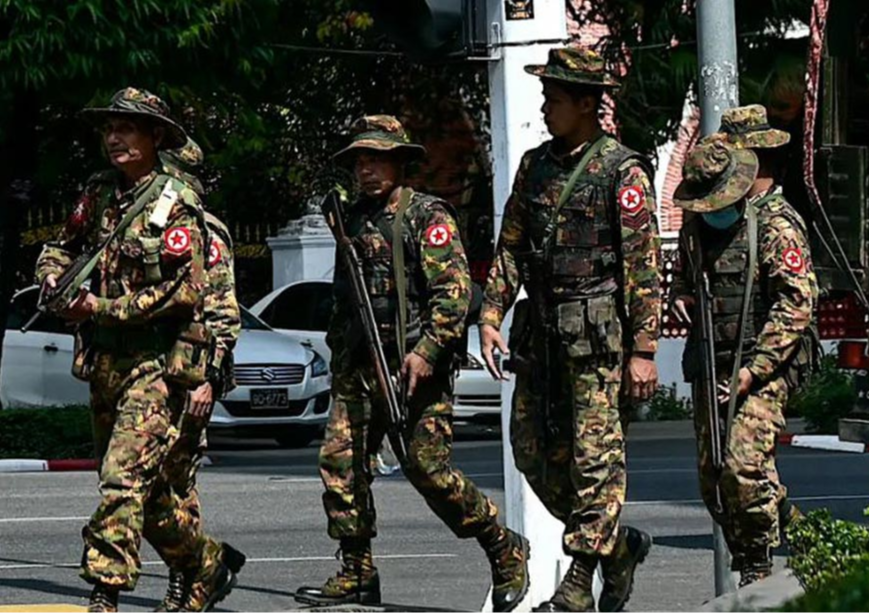
Source Image: WE News
On 8 February 2024, the Government of India (GOI) decided to cancel the Free Regime Movement (FMR) between India and Myanmar to ensure the country's internal security and maintain the demographic structure of the Northeastern states. This decision came days after New Delhi decided to fence the 1,643 km-long Indo-Myanmar border. Given its geography, Myanmar holds strategic and economic significance for India. The country is crucial for India's aspirations to increase its influence in Southeast Asia, specifically among the Association of Southeast Asian Nations (ASEAN) countries, through its Act East Policy (AEP). However, Myanmar has been facing political turmoil since the military takeover in February 2021. The launch of 'Operation 1027' on 27 October 2023, by three brotherhood alliances—the Arakan Army, the Ta'ang National Liberation Army, and the Myanmar National Democratic Army—against the military Junta further exacerbated the instability and impeded India's AEP's core objectives.
Understanding India’s Act East Policy
In 2014, Prime Minister Narendra Modi rebranded the 'Look East Policy' as the 'Act East Policy' and revitalised it with three primary objectives: First, to enhance trade, investment, and cultural relations between emerging India and Southeast Asia, particularly the ASEAN countries. Second, the Policy emphasised creating opportunities and stabilising India's unstable and conflict-prone North-Eastern Region (NER). Third, it endeavours to counter China's growing economic and military power in neighbouring Myanmar, both bilaterally and in collaboration with like-minded ASEAN countries.
The KMMP aims to improve connectivity to India's NER via Bangladesh and Myanmar, linking India's Kolkata port to Myanmar's Sittwe port and extending to Mizoram through highways in Myanmar.
To attain these objectives, India actively pursues regional connectivity with Myanmar through critical projects like the Kaladan Multi-Modal Project (KMMP) and the India-Myanmar-Thailand Trilateral Project (IMTTP). The KMMP aims to improve connectivity to India's NER via Bangladesh and Myanmar, linking India's Kolkata port to Myanmar's Sittwe port and extending to Mizoram through highways in Myanmar. The IMTTP, conversely, will connect India's border town, Moreh, to Mae Sot in Thailand via Myanmar, establishing a land route for seamless trade, business, education, and tourism among all three countries.
Myanmar after the 2021 military coup-
Myanmar's location at the trijunction of South, Southeast, and East Asia crossroads is a gateway for India to expand its land and maritime connectivity to the rest of Southeast Asia and beyond. Beyond its strategic importance, New Delhi considers Myanmar an attractive market and a reliable economic partner for its growing economy. The bilateral trade agreement encompasses 62 commodities under tax exemption, including agricultural products, utensils, cosmetics, motorbikes, and cement, projecting a total merchandise trade of US $1.76 billion for 2022-2023.
Despite these prospects, key AEP projects in Myanmar have faced significant delays. The 68-mile highway linking Sittwe Port (Myanmar) to Mizoram (India), under the KMMP, still needs to be completed despite the Sittwe Port being functional and near completion on the Mizoram side. The IMTTP is 70 percent completed on the Indian side and is near completion in Thailand, too. However, Myanmar has not provided the exact progress report, despite the Trade Minister, Aung Naing Oo, mentioning that only a portion of the highway still needs to be completed, which will take another three years. The political unrest has slowed down both critical projects as violence has escalated between the Ethnic Armed Organisations (EAOs) and the military Junta. Further, the EAOs and the National Unity Government (NUG) control the areas the project passes through—Chin, Sagaing, and Rakhine states. Also, the Paletwa township, strategically crucial for the KMMP, is now controlled by the Arakan Army, with which India has had no negotiations. It has now become imperative for New Delhi to respond to the new realities and interact with these groups to realise these critical infrastructure projects.
The political unrest has slowed down both critical projects as violence has escalated between the Ethnic Armed Organisations (EAOs) and the military Junta.
New Delhi has partnered with the Myanmar government to secure the NER against insurgent threats. A coordinated effort between the Indian Army and the Myanmar Junta has been employed to counteract insurgency by Indian groups operating within Myanmar since the 1990s. Experts posit that implementing the AEP will mitigate armed conflicts in the NER, fostering enhanced connectivity with the ASEAN countries via Myanmar. This transformation is expected to position India's landlocked and less-developed NER into a focal point for economic growth and activities, thereby reducing factors contributing to insurgency, such as unemployment and limited opportunities for the region's youths. However, the military junta's divergence from its commitment to assist the Indian Army in countering insurgency on the Indo-Myanmar border has adverse implications for India's national security. This implication is evident in the November 2021 ambush on Assam Riffle's convoy by the People's Liberation Army of Manipur and Manipur Naga People's Front, using Myanmar as a staging ground for attacks in India. The recent attempt to ambush an army convoy in Manipur’s Tengnoupal district, just a few kilometres from Myanmar, further underscores the negative repercussions.
The heightened influx of refugees has also posed significant security challenges in India's NER, especially in Mizoram and Manipur. The surge in Myanmar refugees has dramatically intensified following the Junta's recent aerial strikes to suppress the resistance forces. Currently, Mizoram is hosting over 60,000 Myanmar immigrants since the 2021 coup. Due to the worsening political turmoil in Myanmar, there is a further possibility of an increase in these numbers. Furthermore, the influx of Chin Kuki refugees from Myanmar is identified as a contributing factor to the prevailing violence in Manipur. This violence has disrupted the Moreh-Tamu border market, vital for Indo-Myanmar bilateral trade. Scholars argue that the ongoing violence in Manipur has adversely impacted the connectivity route along the Indo-Myanmar border, potentially discouraging stakeholders from investing in the NER linked to the AEP. Consequently, the political instability in Myanmar is exerting a detrimental influence on India's NER.
The heightened influx of refugees has also posed significant security challenges in India's NER, especially in Mizoram and Manipur. The surge in Myanmar refugees has dramatically intensified following the Junta's recent aerial strikes to suppress the resistance forces.
China’s growing footprint
The China factor further accentuates the strategic significance of Myanmar to India. China's burgeoning political and economic clout within Myanmar, coupled with its efforts to secure access to the Bay of Bengal via Myanmar, has evoked concerns for India. China's establishment of the China-Myanmar Economic Corridor and the recent establishment of surveillance facilities on Myanmar's Coco Island in the Bay of Bengal have contributed to India's strategic discomfort. Furthermore, China's ascendancy as the principal source of foreign direct investments and its preeminent position as Myanmar's largest trading partner has triggered concerns. India has initiated investment projects in Myanmar under the AEP to recalibrate its position amidst the shifting geopolitical scenario. However, the efficacy of India's strategy to counter China's influence in Myanmar is being questioned. Unlike India, China's approach to Myanmar extends beyond engagement with the military junta; it encompasses interactions with the EAOs and the NUG. This engagement was evident when China brokered a temporary ceasefire between the three Brotherhood Alliances and the military junta in Shan State (broken after three days). India currently lacks this strategic arrangement, mainly because New Delhi believes that engaging with the Junta is a way to limit Chinese influence. Considering the prevailing circumstances in Myanmar, China's multifaceted engagement will gain ascendancy over India's approach if there is a governmental transition in the near future and the EAOs and the NUG form a government.
India has initiated investment projects in Myanmar under the AEP to recalibrate its position amidst the shifting geopolitical scenario.
Conclusion
India's engagement with Myanmar is integral for enhancing regional connectivity, mitigating insurgency in NER, fostering growth and development in the landlocked NER, and countering China's influence. However, political instability in Myanmar is contributing to additional insurgency challenges in India's NER, China's increasing multifaceted engagement, and the influx of Chin refugees. For India, which is keen on increasing its geopolitical and economic clout, there is a need to rethink its strategy towards Myanmar to further its interests and objectives via the AEP.
Ophelia Yumlembam is an M.A. Political Science graduate from Delhi University, India. She is currently working as a Research Assistant at Delhi University, Dept. of Political Science.
The views expressed above belong to the author(s). ORF research and analyses now available on Telegram! Click here to access our curated content — blogs, longforms and interviews.




 PREV
PREV


